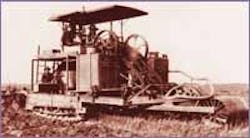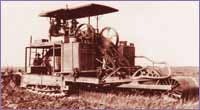Strength from the Past; Power for the Future
Caterpillar celebrated 100 years of the crawler tractor during a worldwide press event in Peoria, Ill., this past November. Few machines have had greater impact in reshaping the past century than the crawler tractor. Starting out as an agricultural machine, its influence has penetrated almost every industry, including mining, logging and construction. Their success depends heavily on the crawler's use and versatility.
Caterpillar also used its press event to launch the new T-series track-type tractors, and even though the new machines with their operator comfort and computer-control technology are in stark contrast to the early machines, the basic principles of the crawler are the same.
The year was 1904 when Benjamin Holt, founder of one of the former companies that established Caterpillar Tractor Co. in 1925, fitted a set of crawler tracks on a wheeled tractor. He could not have foreseen the phenomenal success of his invention and its profound effect on future generations.
Before Holt made it a reality, the crawler track was something dreamed about for decades. Several inventors experimented with various designs, but primitive technology and lack of funding were common causes of failure. Holt, already a well-established builder of big-wheel tractors based in Stockton, Calif., replaced the rear wheels on one of his 40-hp steam-driven units with a pair of tracks nine feet long and two feet wide. On its first field test on Nov. 24, 1904, it reportedly performed with complete satisfaction.
The need for a crawler tractor stemmed from the soft-ground agricultural districts in California. Big steam traction engines frequently mired down in the soft ground, so they were fitted with larger and larger diameter wheels to increase flotation. Then farmers increased wheel widths by fitting side extensions on the wheel rims. The result was a cumbersome machine difficult to maneuver. The belted crawler track was the technological breakthrough needed to solve the problem.
The term "Caterpillar" was first used to refer to a Holt machine in March of 1905. Benjamin Holt took the regular Holt photographer, Charles Clements, out to his ranch to photograph the first Holt crawler tractor in operation. Holt referred to this machine as a "platform wheel engine" and had it working at their ranch near Stockton. When Clements arrived at the ranch, he expected to see a tractor with the usual large driving wheels, but was amazed when he saw the new form of propulsion. He exclaimed in awe, "If that don't look like a monster caterpillar!" That legendary statement caused Holt to adopt Caterpillar as its trademark and register it with the U.S. Patent Office in 1910.
Holt went on to develop a wide range of crawler tractors, first the tiller-wheel type (with the big steering wheel in front) followed by full-crawler machines beginning in 1913. In 1925, rival crawler tractor builder C.L. Best Tractor Co. combined forces with the Holt Manufacturing Co. to form Caterpillar Tractor Co.
Read full details about the evolution of Caterpillar's crawler tractors in the book "Classic Caterpillar Crawlers," by Keith Haddock and Eric C. Orlemann, available for $28.95 post paid from Park Communications, 403/931-1670. Also, consider a membership in the Historical Construction Equipment Association, www.hcea.net.


